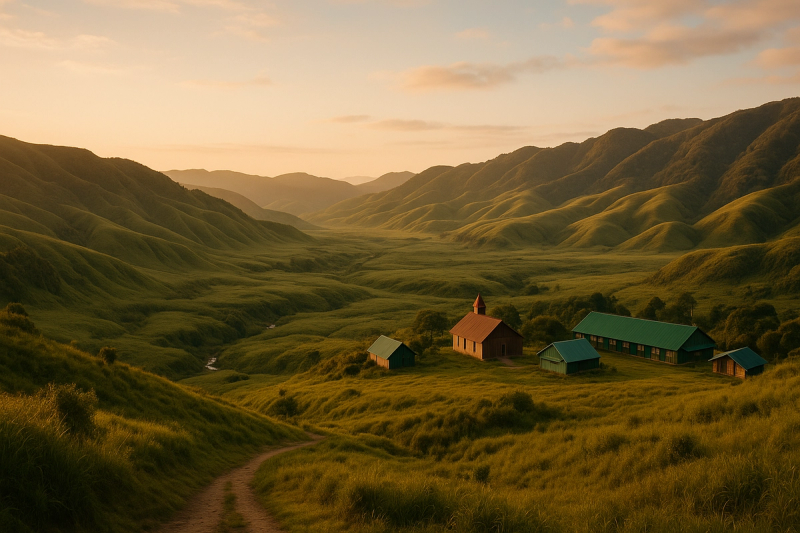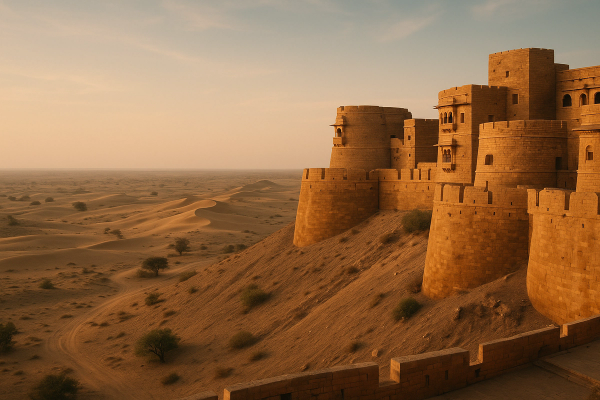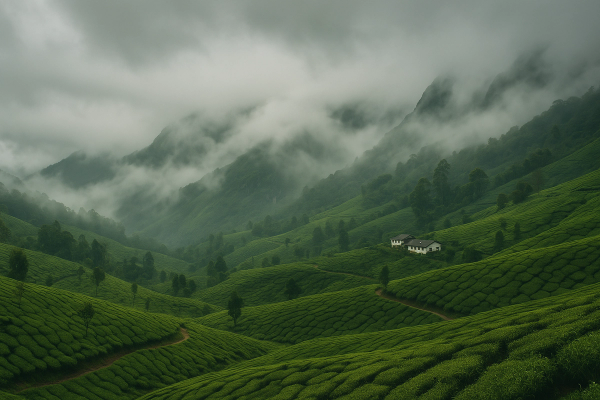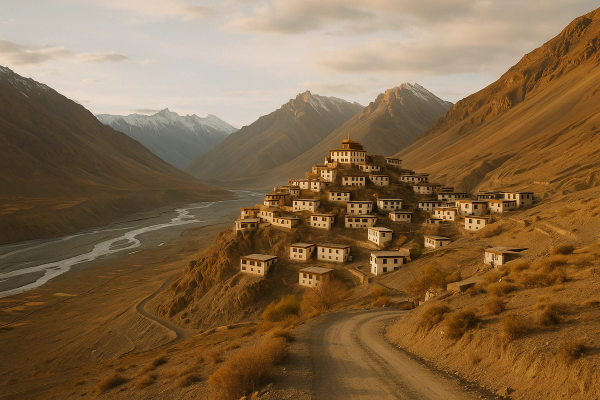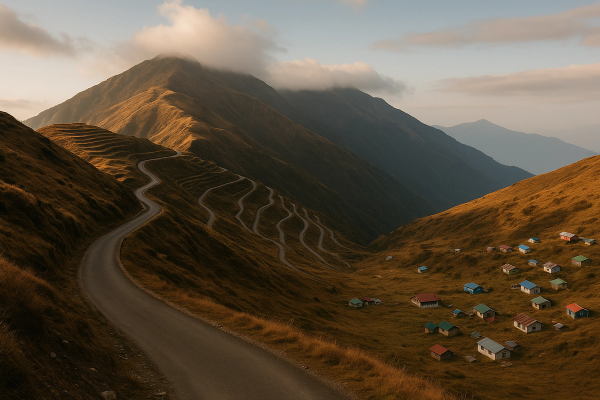Dzukou Valley Trek, Manipur–Nagaland: Season, Permits & Campsites (from a slightly muddied, very happy Indian traveler)#
So, um, I finally did Dzukou. After years of hearing folks in Kohima say “go once, you’ll then keep going again,” I managed to squeeze it in around a long weekend. I kinda went with medium prep (like, not full pro but not totally clueless either) and still got completely blown away. The valley is a living carpet—green waves after the rains, the stream threading through like silver wire, bamboo thickets that keep whispering even when there’s no wind. Photos don’t do it. Your phone becomes useless, your shoes get brown, your breath slows down, and then… it’s just you and this massive bowl of quiet.¶
Why Dzukou was on my list (and probably should be on yours too)#
Honestly, I wanted one trek that felt raw but not impossible. Something I could do over a weekend, without fancy gear. Dzukou sits right on the Manipur–Nagaland border, and it’s handled locally by youth organizations who really care about the place. You feel that, you see the signs and rules, you see how they keep the rest house basic but clean-ish. It’s got that mix of easy-to-plan + a true Northeast vibe—Angami culture, bamboo forests, chilly nights, and those moody skies. And it’s pretty democratic: you’ll meet college kids from Dimapur, solo folks from Guwahati, couples from Imphal, and a handful of us from other parts. Nobody is trying to flex. Just walk, share snacks, laugh at your muddy pants.¶
Latest updates & safety vibe right now#
Travel-wise, things have been mostly stable lately on the Nagaland side, and the valley stays open except during heavy rains or rare wildfire alerts. In past years there were a couple wildfire incidents and short closures, so pls check with SAYO (Southern Angami Youth Organization), Nagaland Tourism, or even your Kohima homestay host for the latest before you go. Mobile network works sometimes on the ridge (Jio had a signal in patches for me, Airtel blinked in and out), but once you drop into the valley, expect almost nothing. Cash is still king at the rest house—UPI may or may not work. The trail has improved signage compared to older stories you’ll read online, and locals keep it clean. If you’re combining it with Hornbill Festival in December, book early—rooms in Kohima fill up quickly that season. I went post-fest season and it was calmer, crisp, soooo nice. And yeah, don’t be surprised if someone mentions last year or 2025 plans casually—life goes on, the valley stays timeless.¶
Season guide: when to go (and, like, why to avoid some months)#
Dzukou is beautiful year-round, but it hits differently in each season. Monsoon (June–August) paints the valley an unreal green and you might catch the Dzükou lily in bloom around mid-season, though trails get slushy and leechy and the steps are wet. Autumn (September–November) is my fave—dry-ish trails, clear skies, warm sun, cold nights. Winter (December–January) brings biting cold and sometimes, once in a while, light snow… it’s magical but your fingers will hate you if you don’t carry proper layers. Spring (March–April) is shoulder season with kinder weather, and rhododendrons start popping around late April/May. Personally, I’d avoid peak rain if you’re new to trekking—unless you enjoy sliding down stairs and, um, sharing your blood with leeches. If you want safe, chill views and minimal drama, aim for late Sep to mid Nov or mid Mar to late Apr. Trust me.¶
Permits, fees, and that small but important eco side of things#
You’ll hear the word “permit” a lot in the Northeast. For Indian travelers, Inner Line Permit (ILP) is required for Nagaland (apply online—nagalandilp.com—or at facilitation centers in Dimapur/Kohima). Manipur also has ILP for domestic visitors; there are counters at Mao Gate and Imphal airport, and you can check the state portal too. Dzukou itself has an eco/entry fee collected at the trail gate or rest house—this is managed by the local youth body (SAYO). It’s not expensive, like a couple of hundred rupees range per person typically, but rates can change season to season. If you’re a foreign traveler, you don’t need the old PAP now for most areas, but please register where required and stay within notified routes. Either way, carry cash. They might note your name, phone number, and ask basic questions, super chill. Also, don’t carry booze up—Nagaland is officially dry and the valley’s rules are strict about alcohol and littering. No campfires. Pack it in, pack it out.¶
Routes: Viswema vs Jakhama (and the Manipur side, if you’re keen)#
Most folks start from the Nagaland side, especially Kohima. Viswema route is popular because it’s a tad gentler. You drive till the last jeep-able section, then walk a long-ish staircase climb through bamboo, hit the ridge in 1.5–2 hours, and then traverse to the rest house in about 45–60 mins. Jakhama is steeper but shorter—good if your knees are solid and you want to get it done faster. Manipur side exists too, near Mao–Senapati area, but it’s less touristy, and route info keeps evolving; if you go that side, definitely go with local guidance. In total, expect 3–5 hours to the rest house depending on your fitness and weather. Difficulty is moderate: lots of steps, some uneven stones, slippery patches in monsoon, but no scary technical stuff. I met a group in chunky sneakers doing ok, though I’d strongly say decent trekking shoes are worth it.¶
Campsites & Dzukou Rest House: what it’s like to actually sleep there#
Atop the valley rim is the Dzukou Rest House with dorm-style rooms, a few private-ish rooms, and designated camping spaces nearby. Don’t expect fancy: thin mattresses, shared toilets, and basic kitchen area where you can order tea/noodles or heat up stuff. Price ranges change—think roughly Rs 300–500 for dorm bed per person, Rs 800–1500-ish for private rooms when available, and tent pitching or rental anywhere between Rs 500–800. Blankets are rented too. These are ballpark numbers—always check current rates at the gate or rest house. Sign-in is simple: pay entry fee, choose your stay type, write your name and start time. Sunset here is a vibe: wind cuts through, valley turns gold, and you cuddle your chai like it’s your firstborn. Camping is allowed only in designated zones near the rest house to protect the valley floor. It’s strict, for good reason.¶
How to get there (Dimapur > Kohima > trailhead) and what it cost me#
If you’re flying, Dimapur is your practical entry (airport + railway). From Dimapur to Kohima, shared sumos run all day from counters near the station—budget roughly Rs 350–500 depending on type and timing. Kohima to Viswema/Jakhama is another short hop: local mini buses or sumos (Rs 50–150), or a hired cab for convenience. If you want a drop to the last motorable point, negotiate with your driver in Kohima (Rs 1200–1800 one way for small cars was the vibe for us, depends on season and road). Coming from Imphal or Senapati, you can base yourself around Mao and look for local guides to the Manipur-side trailhead. Btw, if you carry big backpacks, book two seats or go early—the sumos get cramped fast. Do ILP checks before you leave the city so you don’t lose time at the gate.¶
Food, water, and that one packet of biscuits that saved me#
Water is available at the rest house (refill points). In the valley stream, people do refill, but I’d still treat water if you’re sensitive. The rest house stocks tea, noodles, omelette sometimes, and basic snacks. Don’t expect a full menu. Carry your own trail munchies: chikki, peanuts, bananas, dark chocolate, ORS sachets. In Kohima, eat properly before going—try smoked pork with bamboo shoot, axone flavored dishes, or a plain plate of rice with local veggies. If you’re coming via Manipur, Chakhao kheer (black rice pudding) and chamthong soup are comfort foods pre-trek. One tiny thing: don’t carry super-smelly stuff that animals might fancy, store food tight. Also, you know those Maggi packets you thought you didn’t need? You will need them.¶
Packing and prep: what actually helped (and what I didn’t need)#
- Trekking shoes with grip—no, your slick city sneakers will betray you on wet stone steps
- A light rain shell + a warm layer; nights bite, winds cut… even in shoulder season
- Headlamp or torch; phone flash is meh when fog rolls in
- Cash (eco fees, tea, emergency snacks); UPI is hit-and-miss up there
- Power bank; if the sun is moody, you’ll lose battery faster than you think
- Snacks with salt/sugar; ORS for those moments you feel not-so-great
- Basic first aid; anti-leech spray in monsoon, bandaids, nausea tabs
- A small garbage bag to pack your trash out; don’t leave anything behind
My actual trek story (yes, I slipped, and yes, I’d do it again)#
We started from Kohima after a heavy breakfast—bad idea, I was basically a sack of rice walking. Took a cab to Viswema side, and the road till the last point was decent but bumpy. The staircase climb hits within five minutes. I tried counting steps (why?) and gave up after 150 or whatever. Bamboo surrounds you, and the wind goes hush-hush. We reached the ridge in under two hours, and suddenly the view opened like someone pulled a curtain. Traversed to the rest house, dumped bags, and walked down to the stream before sunset. That descent is pretty… but it’s demoralizing when you know you gotta climb back up. At the stream we just sat, boots off, feet in ice-cold water, not talking much. On the way back I did one comedic slide on a mossy rock—no injuries, just damaged ego. Dinner was noodles, tea, shared stories with strangers, and lights out by 9-ish. Next morning was foggy drama then full sun. Unreal. We headed back before noon and grabbed momos in Kohima like the world was ending.¶
Budget rough-up: how much I spent (and where it went)#
Okay, money talk. Dimapur to Kohima shared sumo: around Rs 400. Kohima local moving around, tea, snacks: Rs 300–600 depending on what you do. Cab to trailhead and back: roughly Rs 1500–2500 total if split among 3–4 people, cheaper if you’re good at bargaining or use shared rides. Eco/entry fees + stay at rest house: Rs 500–1500 per person depending on dorm vs tent vs room + blanket rentals. Food at rest house: Rs 150–400. Misc: Rs 300 for emergency biscuits, chocolates, ORS, and the one rain cover I didn’t end up using. So a very normal, not luxurious 2-day trek can sit around Rs 2500–5000 per person from Kohima, excluding your flight or train to Dimapur/Imphal. Prices shift with season. Carry a bit extra cash—small notes make life easy.¶
Permits recap + small admin tips#
ILP for Nagaland—do it online if you can before travel, saves time. For Manipur, get ILP at airport or border counters like Mao Gate. Keep digital copies + one photocopy if possible. At the Dzukou gate, ask about current eco rules and timings—they might update stuff after rains or when trail repairs happen. Sign the register, pay fees, keep receipt. If a ranger or youth volunteer asks to check, just show them, it’s chill. Don’t try any shortcuts or off-trail wandering to make reels—you’ll only upset locals and risk a fine or worse. And yeah, if you’re timing this around year-end festivals, book stays in Kohima earlier than you think necessary. I learnt the hard way.¶
Lesser-known tidbits and detours (if you have extra legs left)#
If you’re decently fit and the weather plays nice, add the little walk along the ridge beyond the rest house—more valley views, fewer people. Some folks pair Dzukou with Japfu Peak (tallest near Kohima, famous for the giant rhododendron tree) either before or after. If you come via Manipur side, talk to local guides about viewpoints they swear by—there are ledges where the valley bowl looks completely different. Early mornings at the valley stream are the most peaceful; wear sandals to cross sections and keep socks dry. Sunset right behind the rest house ridge is gold-light magic, and stargazing in winter, oh man, brings that crisp million-dot sky. Don’t rush.¶
Culture and respect: don’t be that person#
Dzukou is under the care of local youth bodies and communities. They maintain trails, watch for fires, keep litter in control, and manage the rest house. So, please be decent. Ask before flying drones. No loud music, no alcohol, no cooking outside designated area. Don’t pluck flowers (even if you think it’s just one), don’t write names on walls, don’t leave wet wipes in bushes—nothing. Say hello, smile, share snacks if someone’s struggling (I recieved a peanut packet from a stranger and it was life). The best part about trekking here is how people are helpful in a very normal, non-insta way. Let’s keep it that way, ya.¶
Common mistakes I saw (and did)#
People underestimate the cold at night, even in shoulder season. Carry that extra layer. Folks arrive late at the trailhead and end up hiking in foggy dusk—start early and keep margin. Overpacked camera gear (guilty) which felt like carrying bricks. Hydration: many drink too little water. And footwear… so many smooth-bottom shoes slipping like butter on a hot tawa. Lastly, don’t plan a super tight bus/train right after; the trail can take longer, weather can change, and your knees might file a complaint.¶
Two-day plan that worked for me (flexible, not a rule)#
- Day 1 morning: Dimapur > Kohima > Viswema/Jakhama drop. Start trek by late morning, reach rest house by 2–3 pm. Tea, stream walk, early dinner, sleep.
- Day 2: Sunrise on the ridge, slow breakfast, wander another hour along the rim if clear. Start descent by late morning, reach trailhead by 2 pm. Back to Kohima for food and rest.
Random practicals (btw, super handy)#
Phone network is patchy—tell your fam you’ll go offline. Power at rest house goes off and on, so rely on your power bank. Toilets are usable but basic; carry tissue or a small water bottle. Don’t book a city dinner reservation the same evening—you’ll be late and smell of mud. If you’re going in monsoon, put your phone and wallet in ziplock bags. And if clouds roll in, don’t try to ‘beat’ fog—wait it out, move slow, chat with others, sip tea. The valley teaches patience. Also, tiny tip: write your name on your rented blanket tag; me and him went to sleep swapped and spent 30 mins in blanket chaos.¶
Would I go back? 100%. Twice, probably.#
Dzukou felt like a pause button in real life. Even with all the small annoyances—slippery steps, damp socks, the not-so-hot tea—it’s worth every step. I’d go again in autumn and maybe once in deep winter to try my luck with light snow. If you time it around the Hornbill Festival, it’s a cool combo (but expect crowds). If you want an empty valley slice, shoulder seasons like late March or late October are dreamy. One person’s heaven is another person’s cold nightmare, sure, but Dzukou kinda converts you. Whether you’re planning in 2025 or random next year, the main advice stays the same: prep light, respect heavy, walk slow. If you want more trip ideas and honest travel gyaan, I keep dropping notes on AllBlogs.in—have a look whenever you’re planning your next wander.¶

